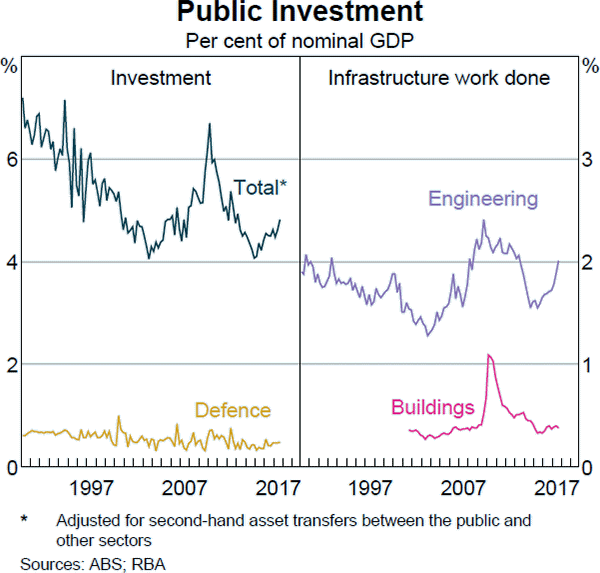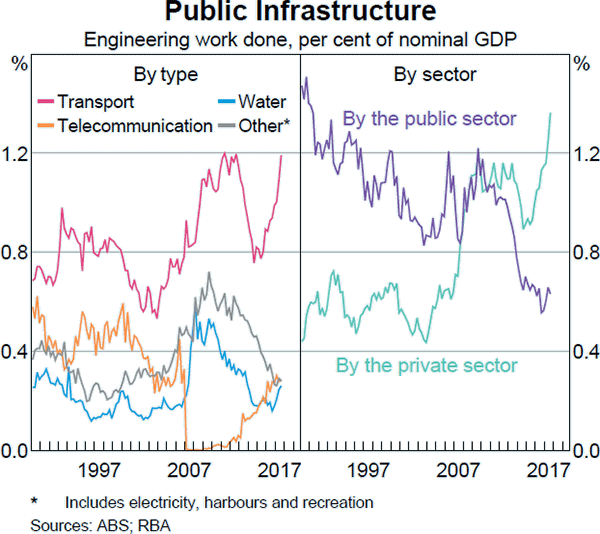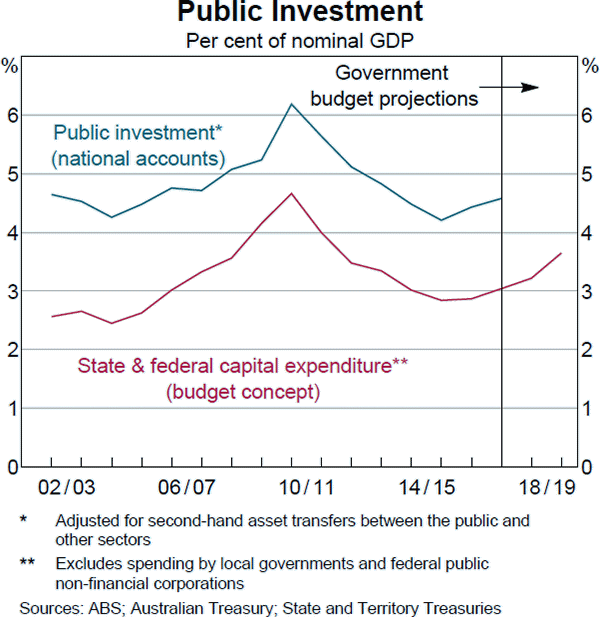Statement on Monetary Policy – February 2018 Box C: Spillovers from Public Investment
Public investment has grown strongly and has increased its share of GDP over the past couple of years (Graph C1). Investment in infrastructure has driven much of the strength and has been concentrated in transport and telecommunications, which includes the National Broadband Network (Graph C2). Nevertheless, public investment remains low as a share of GDP when compared with history. This is largely because previously government-owned entities in capital-intensive industries, such as utilities, have been privatised over time.
Much of the publicly owned infrastructure built in the past couple of years has been constructed by the private sector. Most of the work done by the private sector for the public sector is constructed under contract rather than through public-private partnership (PPP) projects. For PPPs, the private sector assumes some risk in the project, for example via costs associated with ongoing maintenance.[1]
Recent Bank liaison and business surveys suggest that the increase in public spending has supported business conditions over the past year or more. There had been spare capacity in the construction sector following the end of the mining investment boom. More recently, though, liaison contacts have reported that firms involved in this type of work have begun to hit capacity constraints, leading to a pick-up in private investment in machinery and equipment as well as employment.


Capital expenditure projections from the state and federal budgets indicate that public investment will remain strong for some time as work on infrastructure projects continues (Graph C3). This is expected to support further growth in investment by private firms that work in this sector.

There are also spillovers to the broader domestic economy from an increase in public investment. The profits earned by firms and the incomes earned by workers involved in infrastructure projects boost business investment and consumption, although the effect of this on GDP is likely to be offset to some extent by higher imports. Potential output is also boosted by the larger capital stock and any productivity benefits, although this is likely to occur gradually.
Fiscal multipliers estimate the total effect of a change in public investment on GDP, relative to the size of the initial increase in public demand. The Organisation for Economic Co-operation and Development (OECD) estimates that an increase in public infrastructure investment in Australia is associated with a fiscal multiplier of between 1.1 and 1.3 after two years.[2] This would imply that a $1 billion increase in public investment increases GDP by around $1.1–$1.3 billion after two years.
However, estimates of fiscal multipliers vary a lot and depend on many factors.[3] For example, governance arrangements for selecting infrastructure projects are important for realising the potential productivity benefits of public infrastructure spending, as recently highlighted by the Productivity Commission.[4] Estimates of fiscal multipliers are also generally larger when there is spare capacity in the economy, as is currently the case in Australia. If there was not spare capacity, the resulting increase in inflation could induce a tightening of monetary conditions and an appreciation of the exchange rate that would potentially ‘crowd out’ private sector activity. Crowding out can be reduced by governments smoothing their spending over time.
Footnotes
For a discussion of infrastructure PPPs, see Heath A and M Read (eds) (2014), Financial Flows and Infrastructure Financing, Proceedings of a Conference, Reserve Bank of Australia, Sydney. [1]
OECD (2009), ‘Chapter 3: The Effectiveness and Scope of Fiscal Stimulus’, OECD Economic Outlook, Interim Report, March. Available at <https://www.oecd.org/eco/outlook/42421337.pdf>. [2]
Leeper EM, N Traum and TB Walker (2017), ‘Clearing Up the Fiscal Multiplier Morass’, American Economic Review, 107(8), pp 2409–2454. [3]
See Productivity Commission (2017), ‘Shifting the Dial: 5 Year Productivity Review’, Inquiry Report, October. [4]